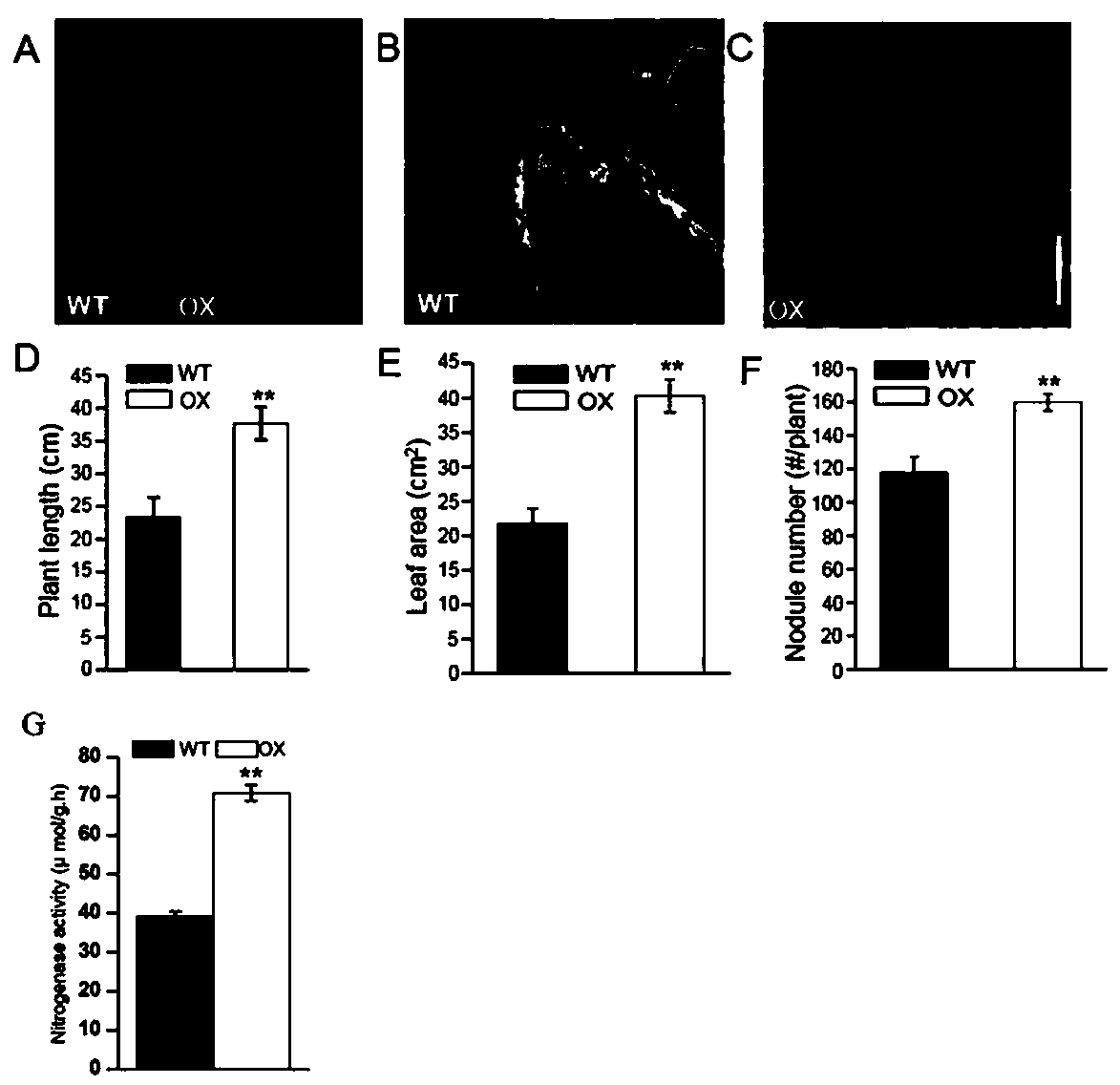Method for improving formation of root nodules of leguminous plants so as to promote their growth
A technology for leguminous plants and higher plants, applied in the field of agricultural biology, can solve the problems of low nitrogen fixation efficiency of leguminous plants, affecting growth and development, etc., and achieve the effects of promoting root cortex cell division, promoting root nodule formation, and increasing leaf area.
- Summary
- Abstract
- Description
- Claims
- Application Information
AI Technical Summary
Problems solved by technology
Method used
Image
Examples
example 1
[0018] Example 1: Construction of SHR expression system
[0019] Soybean root RNA was extracted according to the instructions of OMEGA's E.Z.N.A.® Plant RNA Kit kit. According to the instructions of TransScript All-in-One First-Strand cDNA Synthesis SuperMix for qPCR (TRANS), it was reverse transcribed to obtain soybean cDNA. Find the cDNA sequence of SHR on the soybean genome website (http: / / www.arabidopsis.org / ), and design primers:
[0020] SEQ ID NO.2 SHR(+): 5'-AAAAAGCAGGCTCCATGGATACCACGTTGTTTAGGG-3' and SEQ ID NO.3 SHR(-): 5'-AGAAAGCTGGGTCCGTCAAGGCCCTCCATGCACT-'3; using soybean cDNA as a template, with primers SEQ ID NO.2 and SEQ ID NO.2 and SEQ ID NO.3 ID NO.3 is a primer to amplify the cDNA target fragment of SHR by PCR, and the obtained target fragment is 1431 bp in size, and its nucleotide sequence is shown in SEQ ID NO.1. The target fragment was recovered, and the recovered fragment was connected to the intermediate vector pDNONR221 by BP reaction. Prepare Escher...
example 2
[0021] Example 2: Establishment of plant expression system
[0022] (1) To prepare GV3101 Agrobacterium competent cells, transfer the 35S:pGWB602-GmSHR expression vector into the GV3101 Agrobacterium competent cells, and spread on the cells containing spectinomycin, 50 mg / L final concentration of 100 mg / L Rifampicin and 15 mg / L gentamicin plate screening positive colonies;
[0023] (2) After soybean seeds are sterilized, prepare for transformation after germination;
[0024] (3) Prepare Agrobacterium carrying the target gene, and use liquid LB medium containing spectinomycin, 50 mg / L rifampicin and 15 mg / L gentamicin at a final concentration of 100 mg / L in large batches at 28 °C Shake, shake to OD 600 =1.2~1.6. The Agrobacterium was centrifuged at 2000 r / min for 10 min, the bacteria were collected, and the Agrobacterium was resuspended in 5 wt% sucrose solution (OD 600 =0.8), to obtain the Agrobacterium suspension.
[0025] (4) Infect soybean cotyledons with the Agrobacte...
example 3
[0027] Example 3: Verification of root structure phenotype after expressing SHR
[0028] The function of SHR in plants is very conserved. In Arabidopsis, it can regulate the division of cortical cells and then affect the development of plant roots. Therefore, we apply the function of SHR to soybean, which can effectively change the structure of soybean roots.
[0029] (1) Soybean seedlings constitutively overexpressing SHR were cultivated in soybean nutrient solution, and after 15 days of cultivation, the roots and transverse shoots of soybean were measured and photographed ( figure 1 A). The results in the figure show that the soybean plants overexpressing SHR have significantly thicker root and transverse stems than the wild-type parents.
[0030] (2) Root cortex structure observation test: Soybean plants cultivated for 15 days were taken from the mature area of the root, and soybean roots were embedded with 5 wt% agarose, and the roots were cut into 100 μm thin slices w...
PUM
 Login to View More
Login to View More Abstract
Description
Claims
Application Information
 Login to View More
Login to View More - R&D
- Intellectual Property
- Life Sciences
- Materials
- Tech Scout
- Unparalleled Data Quality
- Higher Quality Content
- 60% Fewer Hallucinations
Browse by: Latest US Patents, China's latest patents, Technical Efficacy Thesaurus, Application Domain, Technology Topic, Popular Technical Reports.
© 2025 PatSnap. All rights reserved.Legal|Privacy policy|Modern Slavery Act Transparency Statement|Sitemap|About US| Contact US: help@patsnap.com



